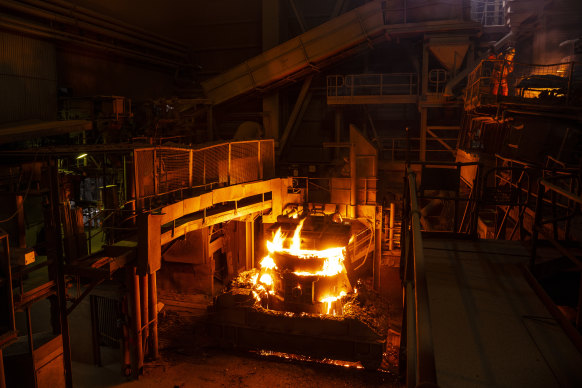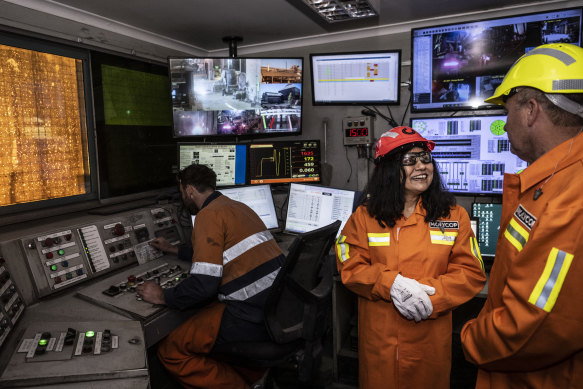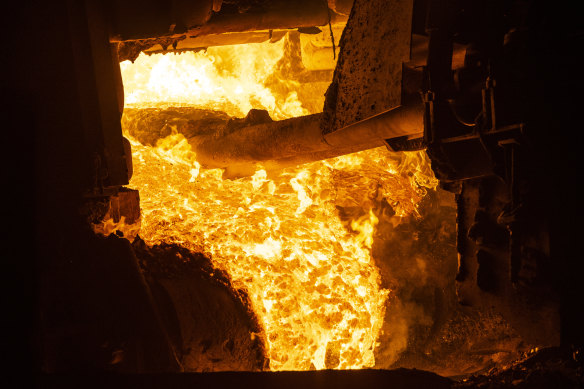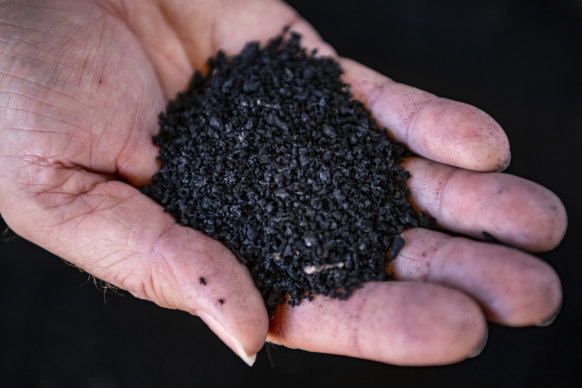
Up close, an electric arc furnace has an overwhelming, elemental presence. Even with hearing protection and safety gear on, even behind the thick protective glass of the control booth, the heat and light exploding from the machine is startling.
Outside the booth the scream of the furnace as it begins to pour steel from its gullet renders even shouted conversations moot.
Steelmaking is known to be at least 4000 years old, and in this steelworks in Newcastle the process still looks like something ancient: slag bubbles away on top of a cauldron of boiling molten metal in a darkened chamber of gantries, cables, and pipes coated in a fine thick grime.
In fact, what has been going on in this room in recent weeks is at the leading edge of global steelmaking technology.
Working with the steelmaker Molycop, scientists from the University of NSW have commercialised a process that replaces coking coal with rubber from used tyres, dramatically reducing the amount greenhouse gasses emitted per tonne of steel produced.
With the process proved, Molycop is in talks to license the technology to a world desperate to clean up steelmaking as it grapples with global warming.
Steel is the world’s single most important engineering and construction material. It is bound so closely to human development that its use surges in lockstep with wealth generation in growing economies like China.
But making steel is a dirty business.
The World Steel Association estimates that in 2021 the global steel industry used about 2.3 billion tonnes of iron ore, 1.1 billion tonnes of metallurgical coal and 680 million tonnes of recycled steel to produce 1.95 billion tonnes of crude steel. In doing so, it dumped about 2.6 billion tonnes, or nearly 10 per cent, of the world’s greenhouse gases into the atmosphere.

An electric arc furnace in action.Credit:Wolter Peeters
Steel is generally made from one of two processes.
In one, iron ore is refined and then combined in a coal-fired blast furnace with coke (which in turn is made of metallurgical coal purified in extreme heat) to provide ingredients such as hydrogen and carbon.
In the other, scrap metal is melted in an electric arc furnace along with coke, which again provides hydrogen and carbon.
At present, there are about 600 electric arc furnaces in the world, representing about 30 per cent of the world’s steel making capacity. They are concentrated in the older advanced economies such as North America and Europe, where there is a more ready supply of scrap steel to feed them. They are becoming more common in China and other parts of Asia as the supply of scrap grows.
It is this use of scrap that attracted the attention of Professor Veena Sahajwalla, who now heads the University of NSW’s Sustainable Materials Research and Technology (SMaRT) centre.

Professor Veena Sahajwalla (centre), the Inventor & Professor of Materials Science UNSW, inside the control room.Credit:Wolter Peeters
Sahajwalla is a world-leading expert in the reuse of materials, a woman offended by modernity’s indulgent embrace of waste.
No material, she believes, should be discarded to landfill after its first use to slowly degrade, releasing potentially valuable molecules to the atmosphere where they contribute to global warming.
Nearly two decades ago it struck Sahajwalla that the highly processed rubber we use to make tyres contains both the carbon and hydrogen needed for steel production.
She says the process to prove her “green steel” vision in the years since has been like conducting an orchestra.
In her early work it became clear that, in a furnace, those requisite hydrogen and solid state carbon molecules might be liberated from the rubber for use. The trick was to ensure they were released at the right time, at the right rate and the right temperature.
As the process moved out of the lab and into Molycop’s furnace over recent years it was clear that this method, now known as polymer injection, could work. “But it had to work in harmony,” she says.
On January 9, Molycop fired up its Newcastle furnace and began using polymer injection commercially.
The process sees a combination of granulated waste tyres and coke injected into the furnace at about 1550 degrees.
The material included the shredded frames of demolished buildings, whitegoods, stoves, industrial equipment, tools and cars.
Sahajwalla’s team is now working to refine the blend further to eliminate coke from steelmaking by adding used coffee grounds to the mix to provide further carbon and hydrogen.
According to Molycop’s vice president for sustainability, Ian Tooze, the Newcastle mill plans to produce about 240,000 tonnes of steel with the process each year, using the equivalent of 90,000 used passenger vehicle tyres (including giant ones used in the mining industry) and displacing about 1000 tonnes of coke.
Molycop is already in talks to license the technology with steelmakers in Europe and North America, and it could potentially displace about 3 million tonnes of coal from electric arc furnace steel production each year.
Obviously, as the process is refined, more coal could be displaced. But the benefits extend further.

Scrap steel being melted in the EAF.Credit:Wolter Peeters
Despite Australia’s wealth of metallurgical coal, Molycop has been importing its coke from China because Australia’s other major steelmakers make their own coke. Now the company is less dependent on stable and long-distance supply lines to make a critical material.
According to Dr Jens Goennemann – the managing director of the Advanced Manufacturing Growth Centre, a federally funded body that helps drive Australian innovation – polymer injection will not only help support Australian jobs and an important sovereign industry in a world growing less stable, it will help some manufacturers meet their emissions reductions obligations under the government’s new climate policy.
It proves, he says, that Australia can keep pace with advanced manufacturing developments as the world races to decarbonise.
Even the reuse of tyres solves a significant environmental problem that is expected to grow as electric vehicles begin to displace internal combustion cars. EVs are heavier and wear out tyres faster.

Rubber crumb from shredded car tyres is used in the steel making process.Credit:Wolter Peeters
Visiting the Molycop steelworks earlier this month, Sahajwalla watched as vast bundles of scrap steel were raised by a giant magnet to be fed to the furnace inside, along with tyre waste injected into the machine.
The material disappearing into the mill included the shredded frames of demolished buildings, whitegoods, stoves, industrial equipment, tools and cars.
Loading
Inside, it was quickly melted by a furnace that, via the grid, drew half its power from wind and solar farms, only to re-emerge an hour later as new steel billets, soon to be forged into train wheels and axles and mining equipment.
Get to the heart of what’s happening with climate change and the environment. Our fortnightly Environment newsletter brings you the news, the issues and the solutions. Sign up here.









 Add Category
Add Category